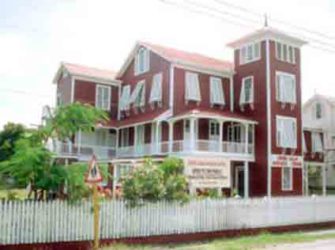Attorney General and Minister of Legal Affairs Basil Williams SC yesterday defended the government’s move last week to retake possession of Red House, arguing that the occupation of the building amounted to trespassing in light of the unlawful manner in which the “purported lease” was granted.
“The transaction was birthed in darkness but on us taking office it came into glorious light. This government pledged during the campaign to restore the rule of law in Guyana and that’s what we are doing and we will continue to do that. So, all of those crocodile tears that have been shed, they have not addressed the fact that at all material times, anyone occupying the land would have been trespassing as well as the building,” Williams said during a press briefing yesterday to address the controversy surrounding the decision. “…We acted properly when we exercised our right… the government right to retake possession of the building and the lands,” he added.


Williams yesterday argued that the purported lease granted to the Cheddi Jagan Research Centre (CJRC) for the Kingston land where the heritage building is located was invalid as it was not sanctioned by any president, in keeping with the law. He also said the lease did not include the building.
According to Williams, a Cabinet decision around 2000 had resulted in the property being placed in the custody of the National Trust. This, he said, prevented the building from being sold, or disposed of otherwise without the sanction of the relevant minister or the president.
He noted that the lease was made under the Land Department Act, which provides for the Commissioner of Lands and Surveys to rent or sell government land albeit with the sanction of the president.
He said efforts were made in 2006, 2010 and 2011 to get approval of then president Bharrat Jagdeo for the lease but it was never signed.
Although he noted that in March of 2012, the lease was taken to court and was signed by the then Commissioner of Lands and Surveys Doorga Persaud and Senior Counsel and member of the CJRC Ralph Ramkarran, he said Jagdeo’s successor, Donald Ramotar, also did not authorise the lease.
Williams also pointed out that the purported lease does not include the Red House building but was specific to the land, that is, lots 65, 66 and 67 High Street, Kingston.
“The lessor hereby leases unto the lessee all that piece or parcel of government land situate at Kingston, Georgetown, more fully described as follows: area A now called Red House comprising lots 65, 66 and 67 High Street, Kingston situate in the city of Georgetown, county of Demerara,” Williams quoted from the lease. “This is clear indication that they could not transact in the Red House building, so they were trying to obfuscate the issue by using Red House instead of using the Red House building… So when we took office in May, 2015, we discovered that this purported lease existed for Red House but they never said the Red House building. When they filed their court action, they did not say we interfered with the possession of the building,” he added.
Williams pointed out that lease should have been executed in a manner of a transport in accordance with the provisions of the Deeds Registry Act for leases cover periods of 21 years and over. The Red House lease is for 99 years at a rate of $1,000 per month.
He explained that the law requires in such cases that the transaction be published in the Official Gazette and advertised in a national newspaper so that if anyone wants to make an objection, a notice of opposition could be filed. “That process was never undertaken by the persons who dealt with the lease. It was a deliberate attempt to hide the transaction from the eyes of the Guyanese people because they knew that such a transaction was unlawful and illegal under the laws of Guyana,” he argued.
Williams said the Deeds Registry Act required that the lease had to be filed in the registry as a matter of record and annotated. He said this was also not done and noted that the last annotation in relation to the property was recorded in 1925. “If it’s not done, you couldn’t plead it in any court of law. You couldn’t assert it in any court of law…and so the case that was filed is asserting that the lease is valid… so I wouldn’t have a long day in court,” he said.
Williams also contended that in light of the lease being invalid, anyone using the building would have been a trespasser and thereby would have no legal right to a notice.
“They had no status as a tenant. In fact, this transaction under Section 10 is not a landlord and tenant situation… they were trespassers,” he said, while rejecting the view that the situation could be likened to a landlord and tenant situation.
He said while some have argued that the government should have moved to the court in order to take possession of the property, the laws relating to government and state lands very clearly provide for criminal trespass and therefore a criminal case could have been brought against the occupants for trespass. Instead, he said, the government sought to resolve the situation through negotiations with the CJRC at its request.
Williams further stated that during one engagement, a CJRC representative proposed that the government should give the organisation a lease of Red House building, which he said implied a clear recognition that they knew the building was not part and parcel of the lease.
It was as a result of the negotiations that Williams claimed the CJRC had almost two years of notice before the government acted. He said the government had no right to provide any notice but did so out of courtesy, before pointing out that the same was never practiced by the previous administration when removing persons from government lands.
On Friday December 30, 2016, one day after President David Granger announced that the lease held by the CJRC would be revoked, a battery of lawyers representing CJRCI moved to the High Court seeking to prevent its eviction and orders were granted on consent to prevent the removal of property from the premises. The matter is returnable for February 20, 2017.
After the court hearing, several men with the insignia of the Ministry of the Presidency on their clothing descended on the property and broke the CJRC signboard and changed a padlock. Police were called in and the men eventually left the building after they were confronted by the occupants.








